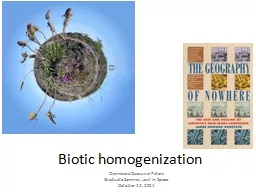

Oyomoare Osazuwa Peters Graduate Seminar Lost in Space October 12 2011 Overview History of Biotic homogenization BH What exactly does BH mean What is the evidence for BH History Episodic mixing of biotas when physical barriers are removed ID: 279975
Download Presentation The PPT/PDF document "Biotic homogenization" is the property of its rightful owner. Permission is granted to download and print the materials on this web site for personal, non-commercial use only, and to display it on your personal computer provided you do not modify the materials and that you retain all copyright notices contained in the materials. By downloading content from our website, you accept the terms of this agreement.
Slide1
Biotic homogenization
Oyomoare
Osazuwa-PetersGraduate Seminar; Lost in SpaceOctober 12, 2011Slide2
OverviewHistory of Biotic homogenization (BH)What exactly does BH mean?What is the evidence for BH?Slide3
HistoryEpisodic mixing of biotas when physical barriers are removedFormation of Panamanian land bridge between N and S AmericaModern recognition of concept by Charles EltonSlide4
What is BH?Laliberte & Tylianakis (2010) refer to it as a phenomenon that reduces variability and uniquess of flora and fauna across regions
.“A gradual increase in compositional similarity among formerly distinct biological communities” (
Naaf and Wulf 2010)“A temporal increase in community similarity” (McKinney & Lockwood 1999).Slide5
“Biotic homogenization is the process by which species invasions and extinctions increase the genetic, taxonomic or functional similarity of two or more locations over a specified time interval” (Olden 2008).
“Biotic homogenization is defined as an increase in spatial similarity of a particular biological variable over
time” (Olden et al. 2004).Slide6
BH definitionChange in similaritySpaceTimeMain driversSpecies invasionsSpecies extinctionsMultiple levels of biodiversity of organizationGenetic
TaxonomicFunctional
Identity of species dictates the outcomeSlide7
Olden 2008Slide8
Olden and Rooney 2006Slide9
Evidence for Biotic homogenization?Slide10
Goal: compare patterns of species invasion, dispersal and impacts on three Eurasian seasPonto-Caspian= The Black Sea + Sea of Azov + The Caspian SeaLow diversity low salinity temperate watersBlack Sea has become an international shipping destinationSlide11Slide12
Goal: to determine how floristic similarity is affected by exotics on a continental scaleData: native and exotic flora of America North of MexicoMeasure: Jaccard index of similarity
J= a/(a + b + c)
J ranges from 0 to 1
a is the number of species shared between two localities
b and c are the numbers of species unique to either localitySlide13
Result: Exotic floras differ more among neighboring communities, but have a broader and more uniform distribution. Slide14
Goal: to quantify extent of functional and taxonomic homogenization across Great Britain between 1978 and 1998Data: National ecological surveillance data for Great BritainScale: random sampling plots of 10 – 200 m2 within 1 km2 regions
Functional traits: canopy height, specific leaf area, dispersal vectors, seed bank longevitySlide15
Space
& Time
SpaceSlide16
Positive correlations between change in α diversity and change in trait variation between 1978 and 1998Conclusion: Plant communities became taxonomically less similar but functionally similar Slide17
Goal: to explore regional and elevational patterns in site similarity throughout the Holocene.Data: eight fossil pollen datasets from RomaniaMethod: They divided time into 250 years intervals from 11500 years BP till recent. Used PCA and Bray-Curtis similarity analysis.Slide18
Conclusion: Biotic differentiation = anthropogenic activities + climate changeBH= biotic interactions as immigration and competitionMost studies that do not account for time represent single snapshots in timeSlide19
Goal: to understand the importance of patterns of extinction at a regional scale Data: species list of amphibian species before and after extirpations associated with a pathogenic fungusApproach: null model Slide20
Results
Pre-decline
Post-declineSlide21
Conclusion: Non random extinctions resulted in the decline of regional diversity of Central American amphibians.Slide22
Goal: to determine whether parasitoid host networks can be homogenized across a gradient of habitat simplificationData: 48 quantitative food websparasitism eventsparasitoid and host compositionunique parasitoid-host interactions Strength of interactionsSlide23
Composition and frequencies of interactions
Host relative abundances
Parasitoid relative abundancesSlide24
Goal: Explicitly test the effect of landscape fragmentation and disturbance on functional homogenization of birds in FranceData: French Breeding Bird SurveyMethod: Community Specialization index (CSI)Slide25
Results: Functional homogenization Slide26
Clavel et al. 2010: Worldwide decline of specialist species: toward a global functional homogenization?Slide27
Goal: to validate a theoretical model predicting the outcome of distinct invasion and extinction scenariosData: freshwater fish faunas in the USA at three spatial scalesCountryProvinces in CaliforniaWatersheds within provincesMethod: used regression analysis
Seeded the model with empirical dataSlide28Slide29
ConclusionFish communities homogenization was at different scales was due toIntroduction of ubiquitous speciesNo extinctionsDifferential patterns of native species extinctionsSlide30
Take home messageThere is evidence for BH at different scalesMost BH studies focus on taxonomic homogenizationNeglect of temporal comparisonMost studies are performed at continental scalesWhat are the implications of BH?Disruption of potential for local adaptation
Reduced resilience of ecosystems to disturbanceSlide31
Papers for discussionOlden et al. (2004) Ecological and evolutionary consequences of biotic homogenizationSmith et al. (2009): Selecting for extinction: nonrandom disease associated extinction homogenizes amphibian biotasAbadie et al. (2011): Landscape disturbance causes small scale functional homogenization, but limited taxonomic homogenization in plant communities.